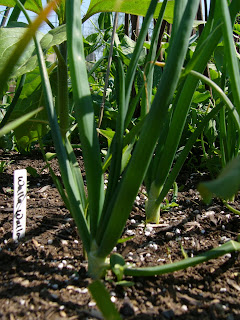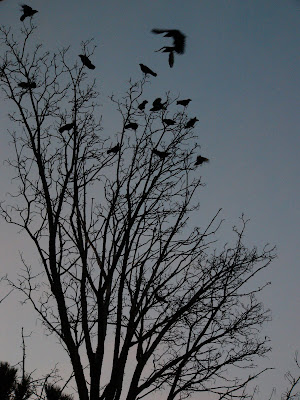Gardening in the Off Season
For a gardener, the end of the growing season is the pits. Unless, of course, you refuse to accept it and force your garden to keep growing. And this is my plan.
And now, on to my winter garden plan. My garden plot is part of a community p-patch where I have about 100 square feet of dirt, for which I pay a nominal fee, volunteer at least eight hours for the patch, and promise to keep my weeds at bay. I'll plant the winter crops on only about half of my garden space. The rest will get a cover crop of crimson clover later this month. It will control weeds and add organic matter to the soil when I till it under in the spring.
So far, my winter garden includes brussels sprouts (I have 15 plants), leeks, lettuce, and radicchio.
The final additions will be hard-neck garlic (I'm planting 'Musik') for harvesting next summer, and lacinato kale (also called dinosaur kale), which, hopefully, will grow enough yet this fall to be harvested in the winter.
A winter garden around here requires no watering, but it does require good drainage and some insulation. Drainage isn't a problem, but I have procured a bale of straw to nestle around my plants for frost protection (or to mitigate Snowpocalypse II, should we get a repeat of last winter). If, like me, you didn't grow up on a farm and were always a bit foggy on the difference between straw and hay, here you go: Straw is essentially the leftover hollow stalks of harvested grains and provides terrific insulation. Hay is essentially baled grass and contains seeds that you really don't want spending the winter in your garden.
I'm hopeful that my winter harvests will coincide with the eating holidays. I'm thinking I will certainly have fresh leeks and radicchio at Thanksgiving. And it would be great to serve my own brussels sprouts for Christmas. If all goes well, they will be a perfect size by then and will have been sweetened a bit by the frost. I'm crossing my fingers.
Yesterday at the p-patch, I visited with a fellow gardener while he worked to ready his plot for winter. I was admiring his harvest of four beautiful pumpkins. Admittedly, I had pumpkin envy. My pumpkin plant yielded only one, small pumpkin. But, I might add, I am inordinately proud of it.
Anyway, he felt a bit down because this was not such a good gardening year for him, pumpkins notwithstanding. Undaunted, however, he told me "Being a gardener is like being a baseball fan. There's always next season and the hope that next year will be the big year."
It's true. A gardener is nothing if not an optimist. I have a feeling that my foray into winter gardening will be delicious. If not, I know next spring awaits.
Growing vegetables in the winter is definitely possible here in the Northwest. And with all my new-found time, I can't think of a good reason not to give it a try.
I must admit, planting and caring for another garden at this time of year doesn't feel quite right. There's something about putting your garden to bed each year that quietly recognizes and shows gratitude for all the bounty of the expiring garden. It feels wrong to just skip over that ritual.
There is a chance, however, that if I give a little tribute--post a few pictures of this season's garden and list everything that it grew--this troubling feeling will go away. It's worth a try.
Summer garden 2009: English peas, lettuce, and a few beets, haricot verts, zucchini (lots of it due to my dubious decision to grow five plants), yellow squash, Walla Walla sweet onions, cippolini onions, Russian banana fingerling potatoes, epazote, dill, scarlet runner beans, nasturtiums, and THE heirloom Connecticut field pumpkin. Volunteer raspberries and blackberries made an appearance too. Nonedibles include lots of volunteer sunflowers, 'Lucifer' crocosmia, three kinds of dahlias, purple asters, golden fennel, shasta daises, coreopsis, and poppies. The only crop failure: cantaloupe.
Summer garden 2009: English peas, lettuce, and a few beets, haricot verts, zucchini (lots of it due to my dubious decision to grow five plants), yellow squash, Walla Walla sweet onions, cippolini onions, Russian banana fingerling potatoes, epazote, dill, scarlet runner beans, nasturtiums, and THE heirloom Connecticut field pumpkin. Volunteer raspberries and blackberries made an appearance too. Nonedibles include lots of volunteer sunflowers, 'Lucifer' crocosmia, three kinds of dahlias, purple asters, golden fennel, shasta daises, coreopsis, and poppies. The only crop failure: cantaloupe.
And now, on to my winter garden plan. My garden plot is part of a community p-patch where I have about 100 square feet of dirt, for which I pay a nominal fee, volunteer at least eight hours for the patch, and promise to keep my weeds at bay. I'll plant the winter crops on only about half of my garden space. The rest will get a cover crop of crimson clover later this month. It will control weeds and add organic matter to the soil when I till it under in the spring.
So far, my winter garden includes brussels sprouts (I have 15 plants), leeks, lettuce, and radicchio.
The final additions will be hard-neck garlic (I'm planting 'Musik') for harvesting next summer, and lacinato kale (also called dinosaur kale), which, hopefully, will grow enough yet this fall to be harvested in the winter.
A winter garden around here requires no watering, but it does require good drainage and some insulation. Drainage isn't a problem, but I have procured a bale of straw to nestle around my plants for frost protection (or to mitigate Snowpocalypse II, should we get a repeat of last winter). If, like me, you didn't grow up on a farm and were always a bit foggy on the difference between straw and hay, here you go: Straw is essentially the leftover hollow stalks of harvested grains and provides terrific insulation. Hay is essentially baled grass and contains seeds that you really don't want spending the winter in your garden.
I'm hopeful that my winter harvests will coincide with the eating holidays. I'm thinking I will certainly have fresh leeks and radicchio at Thanksgiving. And it would be great to serve my own brussels sprouts for Christmas. If all goes well, they will be a perfect size by then and will have been sweetened a bit by the frost. I'm crossing my fingers.
Yesterday at the p-patch, I visited with a fellow gardener while he worked to ready his plot for winter. I was admiring his harvest of four beautiful pumpkins. Admittedly, I had pumpkin envy. My pumpkin plant yielded only one, small pumpkin. But, I might add, I am inordinately proud of it.
Anyway, he felt a bit down because this was not such a good gardening year for him, pumpkins notwithstanding. Undaunted, however, he told me "Being a gardener is like being a baseball fan. There's always next season and the hope that next year will be the big year."
It's true. A gardener is nothing if not an optimist. I have a feeling that my foray into winter gardening will be delicious. If not, I know next spring awaits.













Comments
Post a Comment
Thanks for taking time to leave a note.